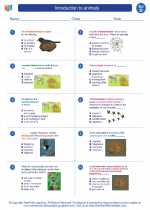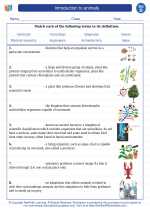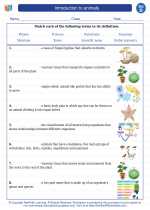Introduction to animals -> photosynthesis
Photosynthesis
Photosynthesis is the process by which green plants, algae, and some bacteria convert light energy, usually from the sun, into chemical energy in the form of glucose, a simple sugar. This process is essential for the survival of most living organisms as it produces oxygen as a byproduct and serves as the foundation of the food chain.
Key Concepts
- Chloroplasts: Specialized organelles in plant cells where photosynthesis occurs.
- Light Reactions: The initial phase of photosynthesis that requires light to split water molecules and produce ATP and NADPH.
- Calvin Cycle: The second phase of photosynthesis in which ATP and NADPH are used to convert carbon dioxide into glucose.
- Factors Affecting Photosynthesis: Light intensity, carbon dioxide concentration, and temperature.
Study Guide
1. What is the primary pigment involved in photosynthesis?
The primary pigment involved in photosynthesis is chlorophyll, which is responsible for capturing light energy.
2. What are the two main stages of photosynthesis, and where do they occur?
The two main stages of photosynthesis are the light reactions and the Calvin cycle. The light reactions occur in the thylakoid membranes of the chloroplasts, while the Calvin cycle takes place in the stroma of the chloroplasts.
3. How does the light reactions produce energy-rich compounds?
During the light reactions, light energy is used to split water molecules, releasing oxygen and producing ATP and NADPH, which are energy-rich compounds.
4. What is the role of carbon dioxide in the Calvin cycle?
In the Calvin cycle, carbon dioxide is used to produce glucose with the help of ATP and NADPH produced during the light reactions.
5. How do factors such as light intensity, carbon dioxide concentration, and temperature affect photosynthesis?
Light intensity: Higher light intensity increases the rate of photosynthesis until a certain point where the rate levels off.
Carbon dioxide concentration: Higher carbon dioxide levels generally increase the rate of photosynthesis, but only up to a certain point.
Temperature: Photosynthesis is optimal within a certain temperature range, and extreme temperatures can inhibit the process.
Understanding the process of photosynthesis and its importance in the natural world is crucial for comprehending the interconnectedness of living organisms and the environment.
.◂Science Worksheets and Study Guides Fourth Grade. Introduction to animals

 Worksheet/Answer key
Worksheet/Answer key
 Worksheet/Answer key
Worksheet/Answer key
 Worksheet/Answer key
Worksheet/Answer key
 Vocabulary/Answer key
Vocabulary/Answer key
 Vocabulary/Answer key
Vocabulary/Answer key
 Vocabulary/Answer key
Vocabulary/Answer key
 Vocabulary/Answer key
Vocabulary/Answer key
